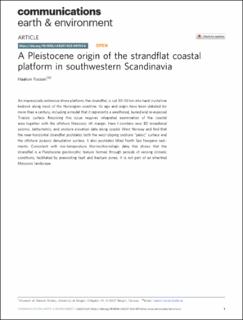A Pleistocene origin of the strandflat coastal platform in southwestern Scandinavia
Journal article, Peer reviewed
Published version

Åpne
Permanent lenke
https://hdl.handle.net/11250/3062576Utgivelsesdato
2023Metadata
Vis full innførselSamlinger
- Department of Natural History [297]
- Registrations from Cristin [9791]
Originalversjon
Communications Earth & Environment. 2023, 4, 63. https://doi.org/10.1038/s43247-023-00724-6Sammendrag
An impressively extensive shore platform, the strandflat, is cut 20–50 km into hard crystalline bedrock along most of the Norwegian coastline. Its age and origin have been debated for more than a century, including a model that it represents a weathered, buried and re-exposed Triassic surface. Resolving this issue requires integrated examination of the coastal area together with the offshore Mesozoic rift margin. Here I combine new 3D broadband seismic, bathymetric, and onshore elevation data along coastal West Norway and find that the near-horizontal strandflat postdates both the west-sloping onshore “paleic” surface and the offshore Jurassic denudation surface. It also postdates tilted North Sea Neogene sediments. Consistent with low-temperature thermochronologic data, this shows that the strandflat is a Pleistocene geomorphic feature formed through periods of varying climatic conditions, facilitated by preexisting fault and fracture zones. It is not part of an inherited Mesozoic landscape.
